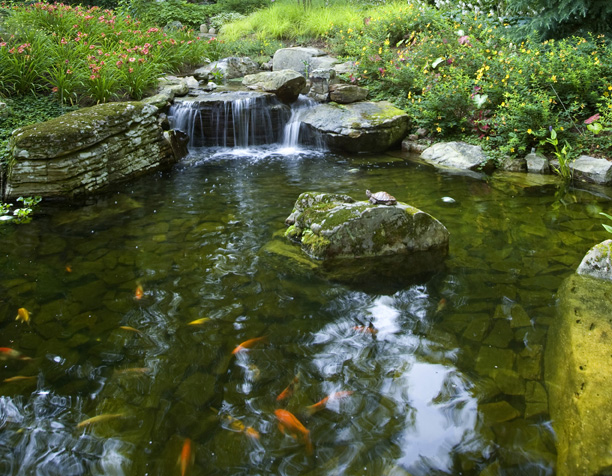Creating a Backyard Sanctuary
 Garden ponds can be a place of tranquility in your backyard. The sight and sound of water creates a relaxing get away from the noise and interruptions of daily life. To ensure your garden pond turns out the way you’ve imagined, here are some important points to cover when you talk with your landscape architect during the design and planning stage:
Garden ponds can be a place of tranquility in your backyard. The sight and sound of water creates a relaxing get away from the noise and interruptions of daily life. To ensure your garden pond turns out the way you’ve imagined, here are some important points to cover when you talk with your landscape architect during the design and planning stage:
- Type of pond
- Location of pond
- Type of pond liner
- Pond Lighting
1 Type of Pond
Aquatic Garden. If you plan to grow aquatic plants in your pond, you’ll need to locate your garden pond in a sunny spot because plants need at least five hours of sunlight per day to thrive. Aquatic plants do best in still water. If you want to include a waterfall in your pond design, you will want to position plants far enough away so they won’t be subjected to a strong current of moving water. This is particularly important for floating plants such as lotuses and water lilies.
Koi Pond. Koi ponds are larger than other garden ponds and have more intensive requirements including:
- Size and depth. To support a healthy fish population a koi pond must be at least three feet deep, provide twenty-five square feet of pond per fish, and no less than 1,000 gallons of water.
- Filtration system. A filtration system is necessary because koi produce a significant amount of waste. There are two types: mechanical and biological. Mechanical filtration uses pump baskets, bottom drains and skimmers to trap fish waste. Biological filtration employs beneficial bacteria to convert toxins into harmless substances.
- Aeration system. Depending on pond size, and the number of plants and fish, you may need an aeration device to circulate oxygen through pond water. Incorporating waterfalls or fountains into the design can accomplish the need for aeration. However, mechanical aeration pumps are worth the investment if you live in a hot climate or have large fish.

2 Location of Pond
Pond maintenance will be more manageable if you pick the right location. Garden ponds that are built under trees can be high maintenance because of leaf litter and debris that ends up in the water. Also, ponds in low-lying spots may be affected by flooding and pollution during rain storms.
3 Pond Liner
 There are three types of pond liners. Going from least to most expensive they are: flexible, preformed and concrete.
There are three types of pond liners. Going from least to most expensive they are: flexible, preformed and concrete.
- Flexible Pond Liner
A flexible liner is best for natural water gardens because it can be cut to any size or shape. A single seamless piece of flexible liner conforms to the excavated shape of the pond. - Preformed Pond Liner
Preformed pond liners are rigid fiberglass shells. Compared to flexible liners, preformed liners are somewhat limited to standard shapes but are easier to install. - Concrete
Poured concrete can be used to create well-defined edges. It can be colored with pigment to make the water in the pond appear darker or lighter.
4 Pond Lighting
Pond lights serve two purposes: safety and visual effect. Safety lighting is used to define the edge of the water and light pathways. Underwater lights can be used to create dramatic effects and highlight certain features of a pond at night.
If you have a particular interest in designing a koi pond, you may enjoy reading Garden Koi Pond: the Bliss of Watching Fish. To answer any of other questions about garden pond design, feel free to speak with one of our landscape architects.
